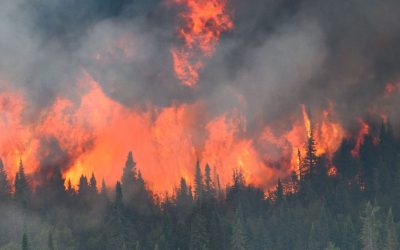Frontier Centre: Is the use of grass pellets as a heating fuel a new idea or old one that is coming back into vogue?
Roger Samson: Historically on the Prairies there was some grass used for heating, I think in tepees and things like that. But basically we are changing the fuel-supply system so that we have a much more convenient fuel by densifying grasses. It is an old idea to use plants for energy, but taking new forms.
FC: You say that switchgrass is one of the best candidates among natural Prairie grasses for conversion into fuel. Why?
RS: Switchgrass is a C4 perennial species, which means it is drought-tolerant and uses water very efficiently. It converts solar radiation into plant matter in a very efficient way, and it is easy to grow and very well adapted to the province where it originated.
FC: Are people manufacturing pellets yet?
RS: In Canada right now, we see that the crop-milling residue industry is the one that is starting up first, because these materials are concentrated, very low in cost and relatively easy to burn. We think that this industry is soon going to be limited in terms of its fuel supply and that grasses will follow in about a year or two.
FC: Don’t new industries encounter a chicken-and-egg problem? Don’t people have to start using pelletized bio fuels before mass production makes sense? How can the price be favourable enough without that to get the industry off the ground?
RS: We already are producing and using about 1.2 million tonnes of pellets in North America, so we have an existing infrastructure we can work into. Combustion appliances now are being developed that can use not only wood pellets, but grains and densified grasses and crop-milling residues. So we really don’t have a problem in terms of the infrastructure to develop the industry.
FC: Are you sure that this industry is viable without government subsidies?
RS: As long as fossil-fuel prices stay where they are, this industry is going to become a major one for Canada, without the need for subsidies.
FC: Compared to burning natural gas, what is the advantage?
RS: We are looking at about a twenty-five percent reduction in heating costs over natural gas, which is currently around eleven or twelve dollars a gigajoule. The advantage also is in greenhouse gases. Every tonne of biomass we use replaces 1.2 tonnes of CO² from natural-gas combustion.
FC: Why does ethanol need subsidies. but pelletized biofuels don’t?
RS: The reason grain ethanol needs subsidies is that its production is not decoupled from the fossil fuel uses. In other words, farmers need a lot of fossil fuels to grow the grains used to make ethanol, and then we need a lot of fossil fuels to build and run the those huge facilities for the conversion process. In the case of direct combustion, we bypass these large facilities and have a much better fuel cycle because we are spending less energy in the conversion process and losing less energy from the feedstock.
FC: What are the macro-ecological advantages? How much fossil fuel can be retired from use if palletized grasses take off?
RS: This industry would help landscape ecology by reducing erosion problems and encouraging biodiversity compared to conventional land use. Here in Manitoba, ten million tonnes of biomass could be produced within the next fifteen years, and that would replace the equivalent of thirty million barrels of oil. In North America we could do up to five hundred million tonnes, replacing 1.5 billion barrels.
FC: What is that per day?
RS: I think that works out to about five percent of the world’s oil supply, around 4 million barrels a day.
FC: Can you briefly explain how credits for greenhouse gas emissions would help this as well?
RS: At the farm level, farmers could get credits for putting their annual crop land into these perennial grasses. You get carbon sequestered in the root systems of these grasses and in the standing biomass, and the users of these fuels would be able to get carbon credits because they are displacing coal and natural gas and heating oil applications. The credits in turn would enable them to offer higher prices to the fuel producers, the farmers.
FC: Assuming Kyoto is a “no go,” does this still work?
RS: It works right now in Ontario and Québec, where we are starting an industry where we have got twenty-five to fifty percent fuel savings without any carbon credits. If we want to replace coal, we are going to need carbon credits. Given the understanding we have about climate change, we are going to need some type of trading mechanism to be able to change the economy over to one based on green fuel.
FC: What about a situation where the government’s deliberate policy is to keep the price of electricity exceedingly cheap?
RS: When you have cheap electricity prices, people are going to use a high-grade energy form like electricity in applications where it is really not required. The higher the price for this high-quality energy form, the more incentive there is for people to use biomass, for example, or geothermal systems, in applications where they can use low-quality heat.
FC: So you would be in favour of raising electricity prices to market values in Manitoba?
RS: I think one thing that Manitoba could do is develop a two-tier system, where they have a base consumption for the household that would be at a modest price and then create a higher price on the second part of the bill that would significantly affect heat-related energy applications. This would provide more revenue for the province and more incentive to switch to other fuels.
FC: You are particularly keen on Manitoba as a location for the use of biomass for heating. Why?
RS: Manitoba is one of the coldest regions in North America, and has the ability to grow abundant volumes of grasses. Manitoba has a strong industry evolving around biomass energy combustion, and no indigenous fossil-fuel resources. That combination gives the district an ideal opportunity to develop bioheat.
FC: You mentioned that the spread for the farmer between the cost of production and what it is worth on the marketplace comes to $140 a tonne. How is that calculated?
RS: If a farmer grows three tonnes of biomass per acre, for example, and has it pelletized, that biomass replaces the equivalent of nine barrels of oil. A barrel of oil is worth (US) $67 today, and when heating oil is delivered to a household it is even more expensive than a barrel of oil in the open market. When you multiply all that through, those tonnes of grass could be worth a lot of money in terms of a value-added market if we could use them in heating applications.
FC: Some describe the burning systems as the “Achilles heel” for grass pellets. Have those problems been solved?
RS: Yes. Necessity is the mother of invention, and what has happened is that combustion equipment has really advanced in terms of manufacturers’ understanding about how to deal with trickier fuels that are high in potassium and chlorine that historically have clogged burners. Combustion improvements have been significant in the past five to seven years.
FC: How does the gasifier work?
RS: Gasification is really a two-stage combustion process, where the energy is released from the biomass through pyrolysis, and the gases then are subjected to secondary combustion, where you get hot burning of those released gases.
FC: How much would installation of a burning system cost the average home owner?
RS: The system that I have in my house is around $4,000, and that is for heating a 1400-square-foot house. If you went to a bigger system, like triple the heat requirement of my house, it would cost you about six thousand dollars for a boiler system.
FC: The idea that you can passively harvest solar energy with grass seems deceptively simple. In your view, what makes the process efficient?
RS: In terms of management, the system is really of benign design. When we look at the Prairies as a model for our energy-production system, these perennial C4 grasses are naturally really efficient. We just need to work with nature and enhance the process of solar-radiation collection with these grasses.
FC: How many units of energy are we putting into the process and how much are we getting out?
RS: For every unit of fossil-fuel energy used for growing the grass and delivering it to a pelletizing facility, for example, we have a multiplier of twenty-three units of solar radiation, about a twenty-three to one ratio of energy output to energy input.
FC: How does that compare to ethanol?
RS: With annual grains, the output-to-input ratio for grain ethanol production would be about four-and-a-half to one, compared to 23:1 for switchgrass. So growing perennial grasses for combustion is about five times more efficient from the start. Then you have the process of converting grains into an alcohol-fuel form like ethanol, which is very energy-intensive. The energy balance ends up at about 1.5 to 1.
FC: So from a “smart green” perspective, it’s much more productive to concentrate on pelletized biofuels than on ethanol?
RS: Yes. A strategy that concentrated on pelletized biomass for thermal heat would produce about seven times more green energy to replace fossil fuels than a liquid-fuel strategy that creates ethanol from annual grains for powering vehicles.
FC: Essentially without subsidies?
RS: That’s right. The ethanol industry requires heavy subsidies because it is very energy-intensive, and it is not decoupled from fossil fuels. With the grass pellet biofuel cycle, we are largely decoupled from fossil-energy requirements.
FC: Were you surprised that George Bush recently mentioned switchgrass as an option for the energy future of the United States?
RS: It was a great thing that he mentioned it. It’s too bad he didn’t do it six years earlier. The Americans are in a very difficult situation in terms of their energy supply. They should restore funding to the programs that were developing switchgrass as a biofuel crop six or seven years ago, before the Bush administration came in.
FC: One of the most convincing arguments that you make relates to the use of marginal farm land for growing fuel. Can you restate that economic case?
RS: The worst poverty in rural Canada is in the marginal farming areas where farmers have very low opportunity costs for that land. Those are the areas that are being depopulated. This is a brand-new energy-supply system that is going to bring prosperity to those areas and strengthen across-the-board commodity prices for all farm crops because of a demand enhancement for agricultural production.
FC: You have been proselytizing about the biofuel advantage for about fifteen years. Did it take high fossil fuel prices to open the door or did these systems always make sense?
RS: There have really been two barriers. One has been the technology barrier, which has largely been solved. The second has been the cheap cost of fossil fuels and that is no longer an issue. We really have no technical or economic barriers in terms of displacing fossil fuels, and with carbon-credit systems we have another economic incentive to make this industry even more affordable and prosperous.
FC: What will this industry look like in twenty years? Do you think it will be well established?
RS: If the climate crisis turns into a serious problem—and it looks like it may—this industry could take off a lot faster than anyone could project.
Read in PDF format here.



